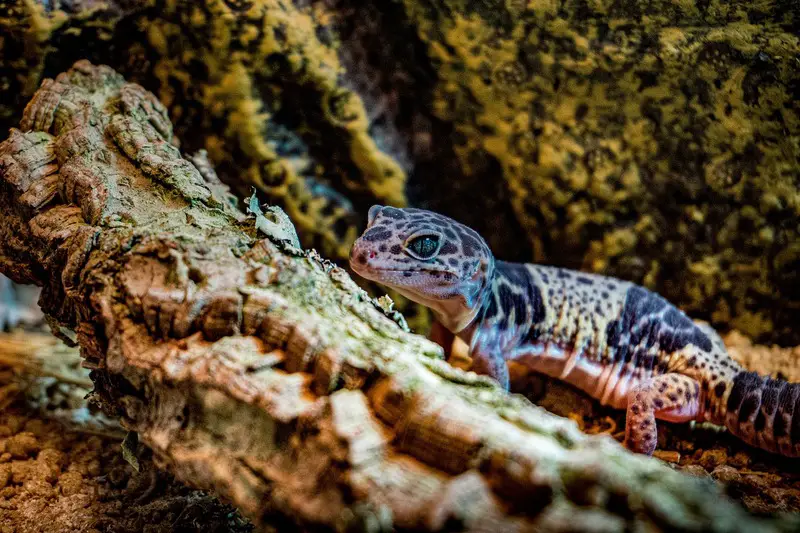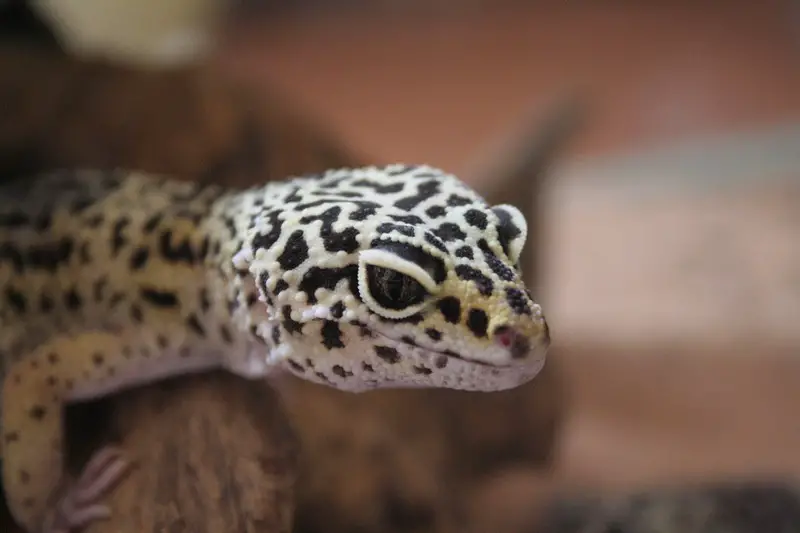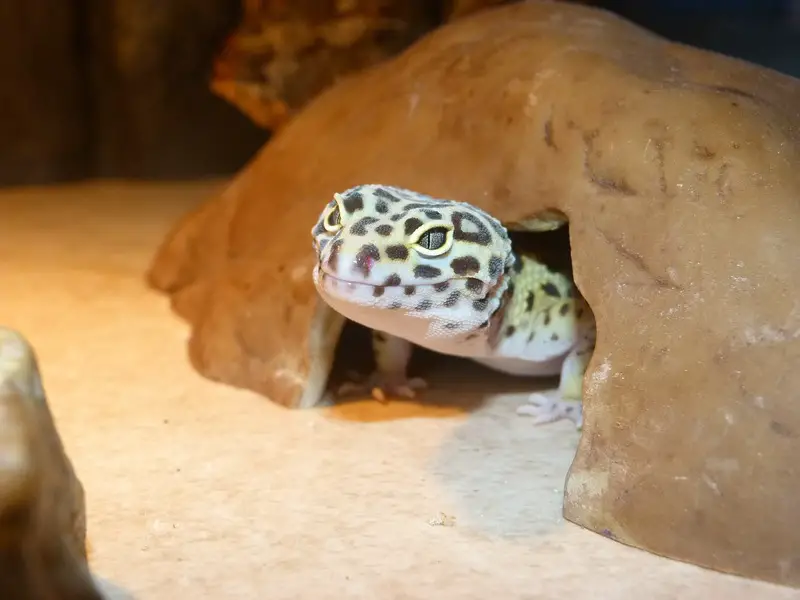Leopard geckos are fascinating reptiles known for their unique characteristics and behaviors. One of the behaviors that often perplexes their owners is their tendency to sleep for extended periods. If you’ve ever wondered why your leopard gecko sleeps so much, this comprehensive guide will provide you with a detailed understanding of this behavior and its various aspects.

Reasons Why Leopard Geckos Sleep
Leopard geckos sleep for various reasons, reflecting both their natural instincts and specific needs in captivity. While the amount of sleep they need can vary from one gecko to another, it’s generally expected for them to sleep during a significant portion of the day and night. Here are the key reasons why leopard geckos sleep:
1. Nocturnal Behavior
Leopard geckos are naturally crepuscular, which means they are most active during the hours of dawn and dusk. This behavior is a part of their evolutionary adaptation to their arid environment in the wild:
- Predator Avoidance: By being active during low-light periods, they can minimize their exposure to potential predators that are more active during the day.
- Temperature Regulation: Leopard geckos avoid the scorching heat of the daytime by being crepuscular. They emerge from their hiding spots when the temperature is more favorable, both for hunting and thermoregulation.
As a result of their crepuscular nature, leopard geckos are often observed sleeping during the day. They conserve energy and remain hidden in their burrows or hiding spots to minimize risk and maximize their activity during their preferred hours.
2. Resting and Conservation of Energy
Leopard geckos, like many reptiles, have lower metabolic rates compared to mammals and birds. This means they do not require constant activity to maintain their energy levels. Sleeping allows them to rest and conserve energy:
- Low Activity Levels: Leopard geckos do not have high activity demands. Their movements are typically slow and deliberate. Sleeping during the day and night helps them rest and recover.
- Energy Conservation: Sleeping helps leopard geckos maintain their energy stores and reserve it for essential activities like hunting, thermoregulation, and digestion.
Leopard geckos often sleep in their hiding spots, burrows, or concealed areas within their enclosure to stay safe and minimize energy expenditure.
3. Thermoregulation
Leopard geckos rely on temperature regulation for their metabolic processes. In their natural habitat, they move to warmer or cooler areas to maintain their body temperature. Sleeping in specific spots can be a part of this thermoregulation:
- Burrowing for Temperature Control: Leopard geckos may burrow or hide in cooler areas during the heat of the day to escape high temperatures. This behavior helps them avoid overheating.
- Emerging at Dusk: During the cooler evening hours, leopard geckos often emerge from their hiding spots or burrows to bask and regulate their body temperature. This is also when they become more active and hunt for food.
In captivity, providing a temperature gradient within their enclosure is essential for mimicking their natural thermoregulation behavior. This gradient should include a warm basking spot and a cooler area, allowing your gecko to choose the temperature that suits its needs.
4. Synchronization with Environmental Conditions
Leopard geckos exhibit behaviors that are closely tied to light and temperature cycles. Sleeping during the day is a response to the natural light-dark cycle:
- Dawn and Dusk Activity: Their crepuscular behavior is synchronized with the changing light conditions at dawn and dusk. During these times, they are more active and responsive to environmental cues.
- Response to Light Levels: Leopard geckos can be sensitive to the level of ambient light in their enclosure. In response to increased light during the day, they often seek shelter and reduce their activity.
By sleeping during the day and becoming active during the low-light periods of dawn and dusk, leopard geckos align their behavior with their natural environment.
5. Comfort and Safety
Sleeping is not only a way for leopard geckos to rest and conserve energy but also a means of seeking comfort and safety:
- Hiding Spots: Leopard geckos often sleep in their hiding spots or burrows where they feel secure and protected from potential threats.
- Reduced Stress: Sleeping in concealed areas helps reduce stress and anxiety, especially when they are in a captive environment.
- Protection from Predators: In the wild, sleeping in concealed spots can protect them from aerial and ground predators.
Providing ample hiding spots and burrowing opportunities in their enclosure is crucial for ensuring their comfort and well-being.

Sleep Patterns and Variations
Leopard geckos typically exhibit consistent sleep patterns, but it’s important to note that individual variations can occur. While most leopard geckos are crepuscular, some may have slightly different activity patterns. Here are some variations you might observe:
- Daytime Sleeping: Many leopard geckos sleep during the day and become active at dusk and dawn. However, some may have slightly different schedules and exhibit activity during daylight hours.
- Nocturnal Activity: While crepuscular behavior is most common, some leopard geckos may become more active during the night. These variations can be influenced by factors such as the enclosure environment and individual preferences.
- Hiding and Resting: Leopard geckos often rest and sleep in their hiding spots or burrows during the day and night. These behaviors are essential for their well-being and security.
- Seasonal Variations: Some leopard geckos may exhibit seasonal variations in their sleep patterns. For example, they might become more active during the breeding season or periods of environmental change.
- Response to Stress: Leopard geckos may sleep more when they are stressed or unwell. Increased sleep can be an indicator of underlying health issues or discomfort.
Understanding the individual sleep patterns of your leopard gecko is crucial for recognizing any changes or deviations that might indicate health concerns or specific needs.
Common Questions About Leopard Gecko Sleep
To further explore the topic of leopard gecko sleep, let’s address some common questions and concerns that owners may have:
1. How Much Do Leopard Geckos Sleep?
Leopard geckos typically sleep for a significant portion of the day and night, often resting in their hiding spots or burrows. While there is some variability, it’s not uncommon for them to sleep for around 16-18 hours a day. This pattern is consistent with their crepuscular behavior.
2. Can Leopard Geckos Sleep with Their Eyes Open?
Leopard geckos can sleep with their eyes open, which is a behavior known as “resting state.” In this state, their eyes may appear partially open, and they can still perceive their surroundings to some extent. This behavior allows them to remain alert to potential threats while conserving energy.
3. Should I Wake Up My Sleeping Leopard Gecko?
Waking up a sleeping leopard gecko is generally not recommended unless you have a specific reason to do so, such as routine feeding or health checks. Disturbing a resting gecko can cause stress, which should be minimized to maintain their well-being.
4. What If My Leopard Gecko Is Sleeping Excessively?
Excessive or prolonged sleep can be a sign of stress or underlying health issues. If your leopard gecko is sleeping more than usual, or if you notice any other concerning symptoms, it’s advisable to consult a veterinarian with expertise in reptile care for a thorough evaluation.
5. Is It Normal for My Leopard Gecko to Be More Active at Night?
Yes, it’s entirely normal for leopard geckos to be more active during the night. This crepuscular behavior is part of their natural instinct and helps them avoid the extreme temperatures and predators of the daytime.
6. Can I Provide Additional Lighting for My Leopard Gecko?
Leopard geckos do not require additional lighting, as they are crepuscular and do not rely on a diurnal light cycle. In fact, exposure to excessive or bright lighting can be stressful for them. Providing a day-night light cycle that mimics their natural environment is sufficient.
7. Should I Adjust Their Sleep Schedule?
It’s generally not recommended to adjust the sleep schedule of your leopard gecko. Attempting to make them more active during the day could cause stress and disrupt their natural behavior. It’s best to respect their crepuscular tendencies.
8. Is My Leopard Gecko Sleeping or Hibernating?
Leopard geckos do not hibernate. If your gecko is sleeping for extended periods, it’s likely a part of their regular behavior. However, it’s essential to monitor their health and ensure they are not excessively lethargic or displaying signs of illness.

Conclusion
Leopard geckos sleep for a variety of reasons, including their crepuscular nature, energy conservation, thermoregulation, synchronization with environmental conditions, comfort, and safety. Understanding their natural behavior and sleep patterns is essential for providing the best care and ensuring their well-being in captivity.
Respecting their need for sleep and minimizing disturbances during their resting periods is important to prevent stress and discomfort. By creating an enclosure that accommodates their natural behaviors and preferences, you can help your leopard gecko thrive and lead a contented life. Regular observations and monitoring are key to recognizing any changes in behavior or health that may require further attention and care.
